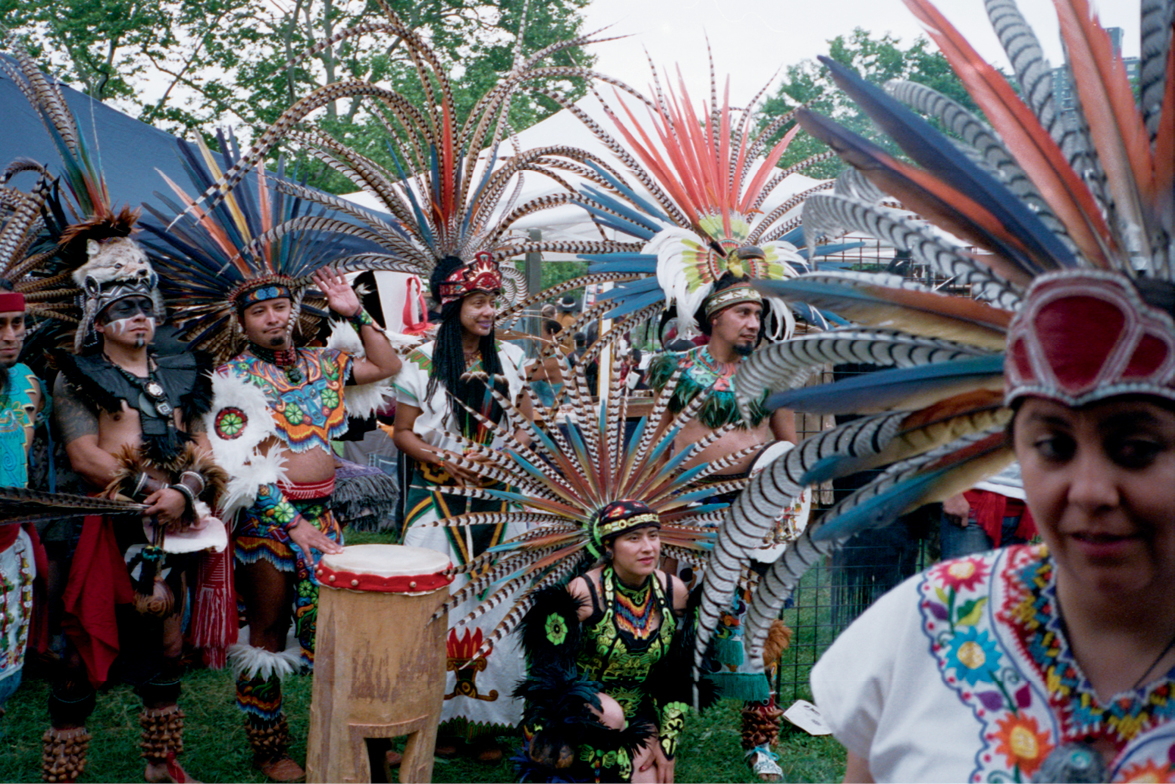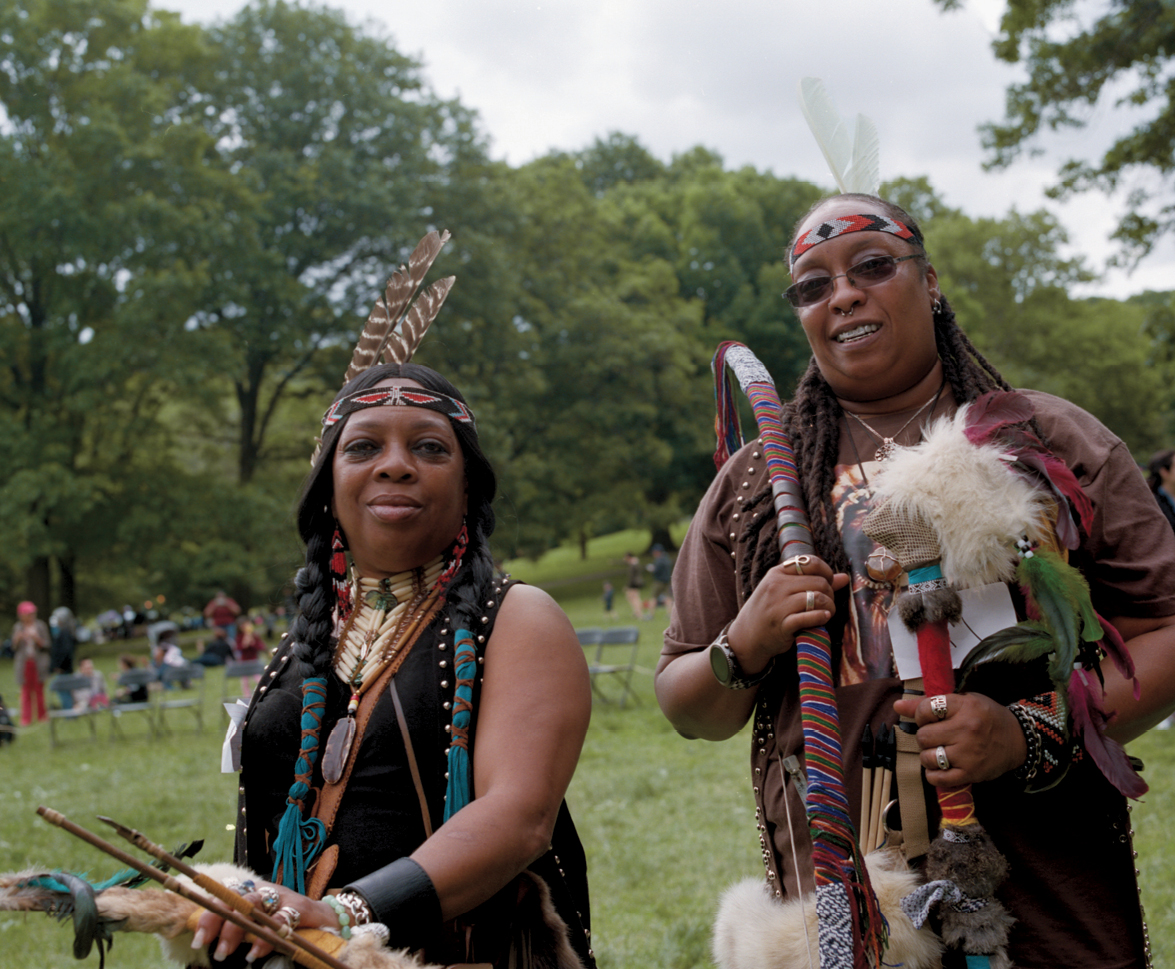
Rahim Fortune
Shinnecock Powwow, 2018
Image courtesy of the artist
THE NOTION OF PRIDE
RAHIM FORTUNE
As an Afro-Indigenous child, I was always told by my grandmother to “be proud to be Native,” although I most often thought of myself as Black.

Rahim Fortune
Shinnecock Powwow, 2018
Image courtesy of the artist
Throughout our childhood, she would make my cousins and me beaded jewelry or paintings for every birthday we had. She enjoyed taking us to powwows and, in preparation, my grandmother and my aunt would design our regalia and teach us how to dance, while explaining the importance of our Native traditions. Most of these things would feel like chores or something we did to make our grandmother happy. It wasn’t until I began to get older that I realized the value of what she had instilled in me.
My grandmother, Margaret Fortune-Myers, grew up in 1940s Virginia, with two brothers and a sister, in a small town called Sands Road. Her father was a Black farmer; her mother a Rappahannock woman who passed away when my grandmother was a child. As a Black and Native woman, she grew up caught between two worlds.
During her lifetime, the Sands Road Courthouse was burned down twice, along with all of the town’s documents and records. When asked about her upbringing, she recalled knowing that she was different, that her hair and skin were telling of a heritage that had survived similar attempts of erasure. When she overheard adults talking about her Native background, she was often told to “Mind your business, grown folks are talking.” Her family thought that they were protecting her from the pain of where she came from. Instead, she struggled with understanding her identity and self-image for a long time. Growing up, as I heard these stories I could feel the pain she experienced. Her pain motivates me to do all that I can to heal this part of our family history.
Children of Native Americans were not allowed to attend public school in Virginia until 1962. Instead, Native children were sent away to “Indian schools” throughout the state and the country. The administration and teachers of these violent boarding schools would strip children of their traditions and culture by forcing children to cut their hair and restricting them from speaking in their Native languages. In some cases it was safer to identify as Black instead of Native, so many families mixed and assimilated into Black Southern life. This allowed my grandmother to avoid being sent away for school. Her two older brothers, on the other hand, were sent to the boarding schools.
“I remember them returning not the same boys they were when they left,” Grandmother recalls. Prior to being taken to these schools, her brothers were hardworking and full of life, but they returned home with an uncharacteristic aggression and began to use alcohol to cope with their trauma.
When my grandmother started her own family (she raised nine children), she did her best to make sure her children took pride in themselves and their culture. My grandmother’s teachings inform my practice as a visual artist. Her constant impulse to both create and share her paintings and jewelry closely mirror my approach to photography.

Rahim Fortune
Grandmother Margaret, 2017
Image courtesy of the artist
In 2017, I left home to move to New York City for college—miles away from the South and the community that I hold most dear. After doing some research online, I learned that New York has one of the largest Native American populations in the United States. More, there is a long history of Indigenous activism in New York City. After arriving to the city, I began attending powwows and other Native-held events such as Drum Along the Hudson and Indigenous Peoples Day. Attending those gatherings, I quickly realized that there was a large population of other Afro-Indigenous folks in New York City. At these celebrations I would see and sometimes meet people who resembled my family and others who saw the same in me.
While attending Indigenous Peoples Day in Harlem, my sister and I met a Black and Cherokee woman who had traveled from Oklahoma to celebrate her ninety-sixth birthday. Upon seeing us, she asked her daughter to flag us down, and in tears, expressed her pride in seeing young people who resembled her, who celebrated our shared background. Moments like this are both healing and affirming.
Many of the people I photographed didn’t grow up in traditional Native households, but our connection to mother earth and shared family histories give us a bond that helps fulfill our need for community. At the powwows we share stories, dance, and honor our elders.
As a photographer I wanted to document this exchange for myself and my family back home, but also for other Native folks who don’t see their stories represented in pop culture. Photographing the Afro-Indigenous people I met allowed me to find an extended family and mentorship from elders here within the city. To me, these photographs represent a visual story that has been passed down from generation to generation and other stories that have been lost.
In 2018, I attended the Annual Shinnecock Indian Powwow, the largest intertribal celebration on the East Coast, held on Long Island on the Shinnecock Reservation. I really wanted to show the level of intertribal solidarity and the amount of care put into the traditional regalia and dance through a photo series. I was granted permission to set up a mobile studio beside the entrance where the dancers were entering and exiting the stage area. I would approach dancers as they finished their performances and ask if they wanted to be photographed. Others would approach me, curious about what I was doing. We would often exchange stories, telling each other where we are from and our tribal connections. Many of the people I photographed were happy to have their pictures taken. The regalia worn in these images was created with so much time and attention to detail. A sense of confidence and pride is clear in the subjects and how they present themselves. I really enjoy sending people the photos I have taken of them, and often provide prints for their families and friends as a way of compensating them for their participation.
It is important for the images to be a collaborative process between me and the person in front of the camera, to ensure the photos are as honest a representation as possible. I recognize that being Native is not a monolithic experience, that we are all unique, so I highly value each person’s distinct perspective. In my series on the Shinnecock Powwow, I knew it was also important for me to document the elegance and beauty of Afro-Indigenous folks, and for us to be in control of our self-image. In our daily lives many of us deal with a sense of invisibility. These images remind me, and I hope others, that we are here, we are seen, and we are loved.
When I moved from Austin, Texas, to Flatbush, Brooklyn, I began photographing the neighborhood, allowing me to connect and share experiences with people in my new home. On the surface I was simply making photographs, but deeper than that, photography allowed me to bridge a gap, developing a deeper sense of community. This exchange closely mirrors my grandmother’s story and her strides to rebuild a sense of self.

Rahim Fortune
Chichimecas, Inwood, New York, 2019

Rahim Fortune
Drum circle brings us closer, Inwood, New York, 2019

Rahim Fortune
Cherokee and Lumbee brothers, Inwood, New York, 2019

Rahim Fortune
Dancers gather along the Hudson River, Inwood, New York
All images courtesy of the artist
FORTUNE